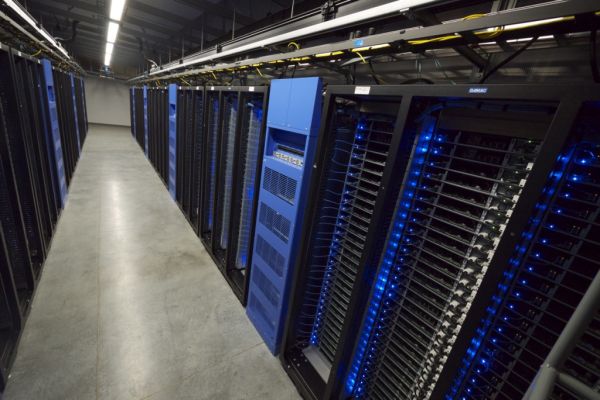Facebook's "Open Compute" Server tested
by Johan De Gelas on November 3, 2011 12:00 AM ESTConclusion
The HP DL380 G7 continues to earn our respect as a very effcient server. It is also a much easier server to handle, thanks to its integrated graphics chip and remote management (BMC). Still, it is clear that these features are not that important for web applications that have to scale out over a large number of servers.

Each rack at Facebook contains 30 Open Compute servers
The Facebook Open Compute servers have made quite an impression on us. Remember, this is Facebook's first attempt to build a cloud server! This server uses very little power when running at low load (see our idle numbers) and offers slightly better performance while consuming less energy than one of the best general purpose servers on the market. The power supply power factor is also top notch, resulting in even more savings (e.g. power factoring correction) in the data center.
While it's possible to look at the Open Compute servers as a "Cloud only" solution, we imagine anyone with quite a few load-balanced web servers will be interested in the hardware. So far only Cloud / hyperscale data center oriented players like Rackspace have picked up the Open Compute idea, but a lot of other people could benefit from buying these kind of "keep it simple" servers in smaller quantities.
Looking back over the past few years, a significant part of the innovation in IT has been the result of people building upon or being inspired by open source software (think Android, Amazon's EC2, iOS, Hyper-V...). We look forward to meeting the new data center and hardware technologies that the Open Compute Project will inspire.










67 Comments
View All Comments
harrkev - Thursday, November 3, 2011 - link
You should look again at the sine-wave plots. Power factor has more to do with the phase of the current and not so much how much like a sine-wave it looks like.As an example, a purely capacitive or purely inductive load will have a perfect sine wave current (but completely out of phase with the voltage), but have a power factor very close to zero...
So, those graphs do not really tell us much unless you actually crank the numbers to calculate the real power factor.
http://en.wikipedia.org/wiki/Power_factor#Non-line...
ezekiel68 - Thursday, November 3, 2011 - link
On page 2:"The next piece in the Facebook puzzle is that the Open Source tools are Memcached."
In fact, the tools are not memchached. Instead, software objects from the PHP/c++ stack, programmed by the engineers, are stored in Memcached. Side note - those in the know pronounce it "mem-cache-dee", emphasizing with the last syllable that it is a network daemon. (similar to how the DNS server "bind" is pronounced "bin-dee") So the next piece is Memcached, but the tools are not 'memcached'.
JohanAnandtech - Thursday, November 3, 2011 - link
That is something that went wrong in the final editing by Jarred. Sorry about that and I feel bad about dragging Jarred into this, but unfortunately that is what happened. As you can see further, "Facebook mostly uses memcached to alleviate database load", I was not under the impression that the "Open Source tools are Memcached. " :-)ezekiel68 - Thursday, November 3, 2011 - link
I was pretty sure it was a mistake and I only mentioned it to have the blemish removed - I've been following and admiring your technical writing since the the early 2000s. Please keep on bringing us great server architecture pieces. Don't worry about Jarred, he's fine too. We all make mistakes.Dug - Thursday, November 3, 2011 - link
I'm curious what the cost would be on the servers compared to something like the HP.Lucian Armasu - Thursday, November 3, 2011 - link
According to SemiAccurate, Facebook is considering Calxeda's recently announced ARM servers, too. It could be a lot more efficient to run something like Facebook on those types of servers.JohanAnandtech - Thursday, November 3, 2011 - link
I personally doubt that very much. The memcached servers are hardly CPU intensive, but a 32 bit ARM processor will not fit the bill. Even when ARM will get 64 bit, it is safe to say that x86 will offer much more DIMM slots. It remains to be seen how the ratio Watt/ RAM cache will be. Until 64 bit ARMs arrive with quite a few memory channels: no go IMHO.And the processing intensive parts of the facebook architecture are going to be very slow on the ARMs.
The funny thing about the ARM presentations is that they assume that virtualization does not exist in the x86 world. A 24 thread x86 CPU with 128 GB can maybe run 30-60 VMs on it, lowering the cost to something like 5-10W per VM. A 5W ARM server is probably not even capable of running one of those machines at a decent speed. You'll be faced with serious management overhead to deal with 30x more servers (or worse!), high response times (single thread performance take a huge dive!) just to save a bit on the power bill.
As a general rule: if the Atom based servers have not made it to the shortlist yet, they sure are not going to replace it by ARM based ones.
tspacie - Thursday, November 3, 2011 - link
The FaceBook servers take a higher line voltage for increased efficiency. What voltage was supplied to the HP server for these tests?JohanAnandtech - Thursday, November 3, 2011 - link
Both servers used 230V. I have added this to benchmark page (Thanks, good question). So in reality the Facebook server can consume slightly less.Alex_Haddock - Thursday, November 3, 2011 - link
TBH we'd position SL class servers for this kind of scenario rather than DL380G7 (which does have a DC power option btw) so not sure it is a relevant comparison. Though I understand using what is available to test.